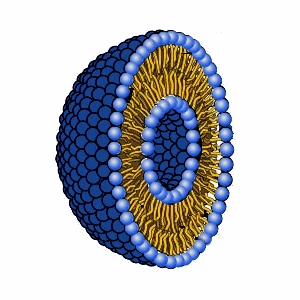 A lipid is an organic compound such as fat or oil.
The important biological functions of lipids include–energy storage, acting as structural
components of cell membranes, and participating as important signaling molecules.
Both lipids and lipid derivatives serve as vitamins and hormones.
A lipid is an organic compound such as fat or oil.
The important biological functions of lipids include–energy storage, acting as structural
components of cell membranes, and participating as important signaling molecules.
Both lipids and lipid derivatives serve as vitamins and hormones.
Lipids are the one class of large biological molecules that does not consist of polymers, which are hydrophobic in nature and are soluble in some non–polar organic solvents such as ether, chloroform, acetone etc.
The hydrophobic behavior of lipids is based on their molecular structure. Lipids are composed largely of carbon and hydrogen that are essential for cell growth. Lipids combine with carbohydrates and proteins to form the majority of all plant and animal cells. Lipids include waxes and certain pigments.
The most important types of lipids are fats, phospholipids and steroids. The important biological functions of lipids include–energy storage, acting as structural components of cell membranes, and participating as important signaling molecules. Both lipids and lipid derivatives serve as vitamins and hormones.
Triglycerides are simple and most abundant lipids. Depending on the structure of the hydrocarbon chains, the fatty acids are classified as saturated fats and unsaturated fats. Excessive consumption of saturated fatty acids is not good, because of their association with atherosclerosis and heart diseases.
 Cholesterol is a lipid (fat) which is produced by the liver.
Cholesterol is a lipid (fat) which is produced by the liver.
Phospholipids are a class of lipids that have amphipathic (pertains to a molecule containing both polar (water–soluble) and non–polar (not water–soluble) portions in its structure) properties, and they are a major component of cellular membranes. Steroids include cholesterol and certain hormones. Steroids have a basic structure of four fused rings of carbon atoms.
One steroid, cholesterol, is a common component of animal cell membranes. Cholesterol is the precursor to human sex hormones and Vitamin D. Vitamin D is formed by the action of UV light in sunlight on cholesterol molecules that have “risen” to near the surface of the skin. Thus, cholesterol is a crucial molecule in animals, although a high level of it in the blood may contribute to atherosclerosis. Both saturated fats and trans fats exert their negative impact on health by affecting cholesterol levels.
Thus, Humans and other mammals stock their longterm food reserves in adipose cells(When energy input is equal to energy output, there is no expansion of fat cells (lipocytes) to accommodate excess. It is only when more calories are taken in than used that the extra fat is stored in the lipocytes and the person begins to accumulate fat.), which swell and shrink as fat is deposited and withdrawn from storage.